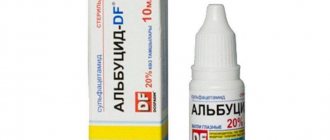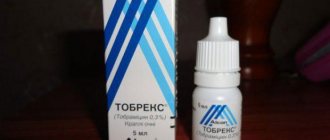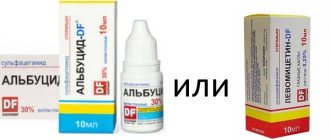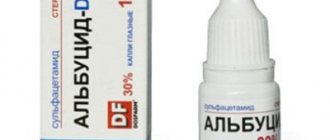132
Author of the article
Tsareva Elena Vladimirovna
Reading time: 11 minutes
A A
The cause of conjunctivitis can be any external influence, including dirty hands, cosmetic samples in stores, or contact with a sick person. But any manifestation of the disease requires immediate contact with a doctor, who can determine the type of conjunctivitis and prescribe appropriate treatment. Albucid is considered one of the most used drugs for the disease.
- Description and composition of the drug
- Medicinal properties and principle of action
- Indications
- Contraindications
- Reaction and side effects
- Preparation
- Features of use in adults
- Use in children
- For different types of illness
- Price and analogues
- Conclusion
Use of Albucid for conjunctivitis
Conjunctivitis is a common disease when the eyes become swollen, watery and painful, and the eyelids cannot be opened due to purulent contents. Doctors often recommend an inexpensive and effective drug - Albucid. Those who decide to get rid of this disease on their own need to remember that Albucid does not always help with conjunctivitis. Therefore, in order to achieve a speedy recovery, before using this drug, you must first study its properties and mechanism of action.
Properties and effects of the drug
Albucid is sold in pharmacies in the form of a clear solution intended for eye drops for bacterial infections. The active substance on which the medicine is made is sodium sulfacetamide. This component has bacteriostatic properties and is active against the following pathogenic organisms:
- Chlamydia.
- Streptococci.
- Escherichia coli, and others.
Staphylococci.
As auxiliary ingredients, the medication contains purified water, hydrochloric acid and sodium thiosulfate.
The drug is available in the form of 10%, 20% or 30% solutions of sodium sulfacetamide. The mechanism of action of this substance is the inhibition of dihydropteroate synthetase and disruption of the production of tetrahydrofolic acid, without which the synthesis of pyrimidines and purines is impossible. That is, after the medicinal solution penetrates the eye tissue, pathogens stop multiplying due to the lack of necessary nutrients, and their death occurs.
Indications
Due to the bacteriostatic effect, these drops are prescribed not only for conjunctivitis, but also for the following ophthalmological pathologies:
- Blepharitis.
- Keratitis.
- Ulcerative lesion of the cornea, accompanied by the discharge of pus.
- Barley.
- Dacryocystitis.
Sometimes the drug is used to treat a runny nose, accompanied by thick, purulent yellow-green discharge, which also indicates the presence of a bacterial infection.
Directions for use and doses
The dosage of the medicine depends on the complexity of the conjunctivitis. So, if you have severe symptoms, you need to instill 1 or 2 drops every 3-4 hours. The medicine should be administered into both eyes, even if the pathological process affects only one eye. As the patient's condition improves, the dosage is reduced. The duration of the course in each specific case should be determined by the doctor.
For the treatment of adult patients, a 30% Albucid solution is used. Children are prescribed the drug at a dosage of 20 or 30%.
Before injecting the medicinal solution into the eyes, it is necessary to thoroughly clean the organs of vision from accumulated mucus and pus. To do this, use a cotton pad soaked in a solution of furatsilin or chamomile decoction.
Also during treatment you must adhere to the following recommendations:
- Each eye should be wiped with a new, clean cotton pad.
- Before the procedure, you need to thoroughly wash your hands and dry them with a towel.
- To avoid infection of others, you should also wash your hands well after instillation.
- The same bottle cannot be used to treat several patients.
- Drops that have been in an opened bottle for more than 30 days cannot be used. This is due to the fact that after the specified period, the drug in the opened bottle loses its medicinal properties, and the use of an ineffective drug can aggravate the course of the disease.
Contraindications and side effects
Albucid is a safe and effective drug that is very often used to treat young children. However, despite its safe composition, this medication has contraindications and can provoke unwanted side reactions.
Contraindications include:
- Hypersensitivity to the ingredients contained in the medicinal solution.
- Age up to 2 months.
Sometimes pediatricians prescribe sodium sulfacyl to children under 2 years of age, but it is strictly prohibited to use it independently when treating newborns, without a doctor’s recommendation.
Drops can provoke the following side effects:
- Increased tear production.
- Burning, swelling of the conjunctiva.
- Discomfort, itching in the eyes.
- Temporary decrease in clarity of visual perception.
- Superinfection.
- Development of severe allergy to sulfonamides.
Analogs
Direct analogues of Albucid eye drops are not available on the pharmaceutical market. The table below lists drops with antimicrobial action, which are used in ophthalmology and other areas for the treatment of purulent processes.
| Name | Compound | Action | Price |
| Tobrex | Tobramycin | A broad-spectrum agent from the group of aminoglycosides. Recommended for inflammatory eye diseases and for the prevention of postoperative complications | 150-250 rub. |
| Tsipromed | Ciprofloxacin | A drug from the group of fluoroquinolones with high activity against bacteria. Prescribed for the treatment of infectious and inflammatory eye diseases. Side effects often include photophobia and lacrimation. Do not use during pregnancy, lactation and children under one year old | 105-140 rub. |
| Phloxal | Ofloxacin | Representative of the fluoroquinolone group. Prescribed as drops for conjunctivitis, dacryocystitis and other eye diseases, as well as for chlamydial lesions of the cornea. Negative effects include dryness and burning in the eye, which disappear after discontinuation. Do not use during pregnancy or in children under 12 years of age | 180-270 rub. |
| Normax | Norfloxacin | A drug from the fluoroquinolone group is used in the treatment of eye and ENT diseases. Prescribed in a complex treatment regimen for purulent otitis, blepharitis, and conjunctivitis. Do not use during pregnancy or in children under 15 years of age | 80-140 rub. |
| Levomycetin | Chloramphenicol | One of the oldest remedies for the treatment of purulent processes in ophthalmology. Due to long-term use, some bacteria may not be sensitive to this medication. Well tolerated, but may not be effective in case of superinfection | 10-30 rub. |
Read more Drops Gilan: instructions for use, composition, analogues and reviews
Overdose
There are no data regarding overdose of sodium sulfacyl in medical practice. When applied topically, an overdose of the drug is excluded, since a small amount of the active substance enters the systemic bloodstream. Complete elimination of the drug from the body occurs after 14-16 hours, the half-life is about 8 hours.
If you accidentally swallow a large amount of medicinal solution, you should immediately see a doctor.
pharmachologic effect
As a derivative of the sulfonamide group, Albucid has a bacteriostatic effect. It inhibits the synthesis of proteins that are necessary to build the walls of most bacteria. Thanks to this action, the bacterial cell stops its division and development, and after some time is destroyed by the human immune system.
Pharmacodynamics
The drug is active against most both gram-negative and gram-positive bacteria, which can cause inflammatory diseases. The drug has activity against intracellular pathogens (chlamydia, mycoplasma), which allows its use for ocular complications of chlamydial infection.
Pharmacokinetics
When used topically, the active substance enters the fluids and tissues of the eye. It can be absorbed into the systemic circulation through the irritated conjunctiva, but does not exhibit a systemic effect due to low dosages and concentrations.
Special instructions and precautions
Sulfacetamide enhances the effect of indirect anticoagulants. When using drops with procaine, benzocaine or tetracaine, a decrease in the bacteriostatic effect of the active substance Albucid is observed. These drops cannot be used with silver salts due to their incompatibility. Also, you should not use Albucid simultaneously with chloramphenicol, as this may cause increased adverse reactions of the latter. In addition, during treatment, it should be taken into account that sulfacetamide can increase its toxicity when used simultaneously with diphenin, salicylates and para-aminosalicylic acid.
Some remarks
Patients with a history of hypersensitivity to furosemide, thiazide diuretics, carbonic anhydrase inhibitors, or sulfonylureas may experience increased sensitivity to sulfonamides.
Those categories whose work requires intense vision and increased attention when working with vehicles and other moving mechanisms should be careful. The drug may cause temporary blurred vision.
Read more Zinc sulfate-dia drops: instructions for use and reviews
How can Albucid be replaced in the treatment of conjunctivitis?
If it becomes necessary to replace albucid with any other drops, you should choose ophthalmic solutions that have a wide spectrum of antibacterial action. Such medications include:
Oftadek
Eye drops based on decamethoxin, a substance that has pronounced antiseptic and antimicrobial properties. Drops are prescribed for chlamydial lesions of the organs of vision, conjunctivitis, blepharoconjunctivitis, purulent-inflammatory processes caused by the following types of pathogens:
- Pneumococci.
- Staphylococci.
- Gonococci.
- Streptococci.
- Enterobacteriaceae.
- Meningococci.
The medication is also effective against eye infections with Candida fungi and some viruses.
Side effects can manifest themselves in the form of pain, itching, swelling of the eyelids, increased tear production, and redness of the conjunctiva. Contraindication: hypersensitivity.
Tobrex
The medicine contains tobramycin, a substance that has antibacterial properties and is effective for eye diseases caused by:
- Staphylococcus.
- Streptococci.
- Klebsiella.
- Enterobacteria and other pathogens.
The medication is prescribed for conjunctivitis, blepharitis, keratitis, iridocyclitis, keratoconjunctivitis of bacterial origin.
After administering the medicine to the eyes, itching, swelling of the eyelids and conjunctiva may occur. The product should not be used if you are highly sensitive to tobramycin.
Tsipromed
Drops for the treatment of ophthalmic diseases - uveitis, keratitis, conjunctivitis, dacryocystitis. The pharmacological solution is developed on the basis of tsipromed, a substance that belongs to the fluoroquinolone group of antibiotics and has antibacterial as well as bactericidal properties. Tsipromed is effective for diseases caused by:
- Klebsiella.
- Staphylococcus.
- Streptococci.
- Chlamydia and other pathogens.
After instillation, the medication may cause a feeling of sand, pain and itching in the eyes, hyperemia of the mucous membranes, and photophobia. The medicine cannot be used for the treatment of children under 1 year of age, with hypersensitivity, pregnancy and hepatitis B.
Levomycetin
The medication in the form of eye drops contains chloramphenicol, which has antimicrobial properties and has a bacteriostatic effect. It is active against the following pathogens:
- Streptococci.
- Salmonella.
- Staphylococci.
- Klebsiella.
- Shigella and others.
Drops are prescribed to patients suffering from infectious and inflammatory diseases of the organs of vision. Caused by the pathogens listed above. Thus, this remedy is effective for conjunctivitis, keratitis, blepharitis, keratoconjunctivitis.
After instillation, the medicinal solution can cause swelling, redness and itching in the eyes, and skin rash in the eyelid area.
Levomycetin has such contraindications as pregnancy and breastfeeding, hypersensitivity, liver and kidney failure, fungal infections of the epidermis, eczema.
Please remember that you should consult your doctor before using any eye drops. Improper treatment of conjunctivitis can lead to the development of complications and deterioration of the visual organs.
Permitted and prohibited drops during breastfeeding: what mothers should know
Eye diseases require immediate treatment, usually local. And lactation makes you wary of taking any medications. After all, some of them can pass through milk to the baby. Therefore, eye drops should be used with caution when breastfeeding. Among them there are some that should not be used at all during this period.
Common eye drops: do's and don'ts
It is necessary to get rid of an eye disease like any other. An infection that has captured the visual organ is caused by microorganisms that migrate easily. That is, the disease can spread and become even more threatening and global. Then it can be passed on to the child.
The instructions for many eye drops contain information about the undesirability of use during lactation, for some there is a direct ban on it. In some cases it is recommended to use with caution.
But nursing mothers are still worried that eye drops during lactation will harm the baby, even when the doctor prescribes them. In order not to worry in vain, it is worth knowing about the entire range of such drugs.
Is it necessary to interrupt breastfeeding?
Even if a woman intends to use antibacterial eye drops as prescribed by a doctor, she should not immediately interrupt breastfeeding. Without reservation, this should be done only if several factors coincide:
- the child is less than 3 months old (the infant’s body is still very vulnerable and can react unpredictably to the mother’s use of medications);
- the instructions for the drug clearly prohibit its use during lactation;
- The doctor categorically insists on temporarily transferring the child to artificial formula feeding.
The absence of these circumstances allows the combination of treatment with eye drops and hepatitis B. To prevent drugs from becoming a source of problems for the baby’s health, there are rules for use:
- You should not prescribe treatment yourself. Almost all products have safer analogues, but only a specialist can tell you which one to choose.
- If you need help urgently, but it is not possible to see a doctor immediately, it is permissible to use any drops suitable for treating the problem several times. This will not cause much damage to the baby. But later you should still consult an ophthalmologist.
- When visiting a doctor, be sure to mention that there is an infant in the house. This will help you choose the best option for treating your mother’s eyes.
- Use drops according to instructions. You should not exceed the dosage if you want to recover faster. For the treatment to be effective, you need to be able to apply eye drops correctly. You should pull back the lower eyelid and inject the drug without touching the tip of the bottle to the mucous membrane or skin. Then you need to blink several times so that the product is distributed over the surface of the eyes.
- It is imperative to monitor the child’s reaction. If diarrhea occurs or skin rashes appear, the baby becomes restless, it is possible that the influence of the tiny amount of medicine that has penetrated into the milk is to blame.
We recommend reading the article about drops for a runny nose during lactation. From it you will learn about the treatment of a runny nose in a nursing mother, the use of drugs with a vasoconstrictor effect, the possibility of using antibiotics and immunomodulators.
The desire to breastfeed your son or daughter is commendable. But it should not contradict taking care of your own health. Otherwise, the baby remains at risk of getting sick. And with a reasonable approach, you can combine the treatment of the mother and the comfortable existence of the child.
Source: https://GrudInfo.ru/glaznye-kapli-pri-grudnom-vskarmlivanii/
Main characteristics of the drug
Albucid (Sulfacyl sodium) is an effective antibacterial drop belonging to the sulfonamide group. The main active ingredient of the drug is sulfacetamide. The following components are also observed in the composition of the medicine:
- water;
- sodium thiosulfate;
- hydrogen chloride.
Previously, Albucid drops were produced in several forms, but today the drug can only be found in the form of transparent drops in polymer bottles with a capacity of 5 or 10 ml. Sulfacetamide has bacteriostatic and antimicrobial properties. After instillation, the active substance penetrates the eye tissue and prevents the proliferation of pathogenic microorganisms. As a result, bacteria do not receive the necessary nutrients, stop multiplying and die.
During the treatment of conjunctivitis with Albucid, it is not recommended to use medications that contain silver salts. Concomitant use of Procaine or Tetracaine weakens the effect of sulfacetamide. Ophthalmic drops are sold without a prescription at an affordable price. The shelf life of the medicine is 28 days after it is opened. If you use the drug after this time, there will be no positive effect.
Price and analogues
The average price for Albucid eye drops is 45-50 rubles. The cost of the drug also depends on the concentration of the active ingredient and the volume of the bottle.
Analogs of the drug include eye drops Tobrex, Levomycetin, Tetracycline and others.
Indications for use of drops
The ophthalmic drug Albucid is prescribed for the treatment of bacterial conjunctivitis caused by chlamydia, cocci, E. coli and some other pathogenic microorganisms. For other forms of conjunctivitis, this medicine is ineffective and can provoke an increase in the inflammatory process. For allergic or viral conjunctivitis, sulfacetamide can be used only if secondary infection is observed. Albucid is prescribed for the following pathological conditions in adults and children:
Albucid: medicinal properties and principle of action of drops
Albucid (sulfacetamide) drops are famous for their bacteriostatic and bactericidal effects on pathogenic microorganisms. They suppress the development of many strains of bacteria, as a result of which the latter lose their ability to reproduce.
Regular use of Albucid for bacterial conjunctivitis helps reduce the degree of redness, eliminate itching and burning, and reduce pain. This medicinal solution has a disinfecting effect on eye tissue, gradually reducing the intensity of the inflammatory process.
Contraindications and side effects
Albucid is a safe and effective remedy for bacterial conjunctivitis, which instantly penetrates through the inflamed conjunctiva into the systemic bloodstream of the anterior segment of the eye, providing a short-term effect. The maximum concentration of the drug in the blood is observed after a couple of hours and decreases by half after 8 hours. The medicine is completely eliminated from the body after 14-16 hours.
Despite the safety of the medication, it cannot always be used. It is forbidden to instill Sulfacyl sodium in the eyes for conjunctivitis if you have an individual intolerance to sulfonamides. It is also not recommended to use Albucid if you have an allergic reaction to thiazide diuretics, carbanhydrase inhibitors or sulfonylureas. During gestation and lactation, the drug can be used, but only under the supervision of a doctor.
Sometimes the following side effects occur after using sulfacetamide:
Contraindications
The main contraindication to the use of Albucid is the patient's hypersensitivity to sulfacetamide and other drugs containing sulfonamide. The drug is also not recommended for use in patients allergic to thiazide diuretics. These drops are used with caution during pregnancy and lactation and only after consultation with a doctor.
Wearing contact lenses also cannot be combined with taking Albucid, so you should avoid contact lenses during the treatment period.
Instructions for use
To achieve a positive result from the treatment of conjunctivitis with Albucid drops, you must adhere to the following instructions for use of the drug:
- Cleanse your eyes of purulent discharge using Furacelin solution or chamomile decoction.
- Hold the bottle of medicine in your hands for several minutes, warming the contents.
- Tilt your head back a little, lift your pupils up.
- Pull back the lower eyelid with one hand and, using the other hand, drop 1-3 drops of solution into the conjunctival sac.
- Repeat this manipulation on the other eye.
- Close your eyelids and press the inner corners of your eyes with your fingertips to prevent any drops from escaping. Sit in this position for a couple of minutes, ensuring good absorption of the medicine.
- Remove any remaining drops with a napkin or cotton pad.
The dosage of Albucid for conjunctivitis is determined individually, taking into account the severity of the disease. In acute cases of pathology, it is recommended to instill 1-2 drops every 3-4 hours. As symptoms subside, the number of instillations can be reduced. The exact course of treatment is determined by the doctor.
Dosage and administration
The method of using Albucid for common eye diseases in adults is presented in the table below.
| Indications | Mode of application |
| For barley, conjunctivitis, blepharitis and other eye infections | 30% solution:
|
| For the prevention of infectious processes after surgery in the organ of vision | Albucid 20% (less often 30%): 2 drops in both eyes × 3-4 times a day. |
The sooner you start dripping the medicine, the more effective the treatment will be.
When using Albucid eye drops, follow a simple algorithm:
- Tilt your head back slightly and, with clean hands, pull down the lower eyelid until a depression forms between it and the eyeball.
- Look up and bring the tip of the bottle to the previously formed space (avoid contact with the eyeball!).
- Gently place 1-3 drops under the lower eyelid.
- Close your eyes and press your index finger on the inner corner of your eye for a few seconds: this will prevent the medicine from entering the nasal cavity through the tear duct.
- Repeat the same with the other eye.
If you wear soft contact lenses, be sure to remove them before instilling the medication as they may lose their clarity. Ophthalmologists recommend replacing lenses with glasses for the entire treatment period.
The course of drug therapy is determined by the doctor individually. On average it is 5-7 days.
Use of Albucid in childhood
Sulfacyl sodium is a drug with proven safety, so it can be used to treat ophthalmic diseases in young patients, including infants. Albucid for children aged 0-14 years is prescribed only at a dosage of 20%:
- for the treatment of microbial lesions of the eye, it is recommended to drop 1-2 drops × 4-6 r/day. (depending on the severity of the disease);
- Prevention of blenorrhea is carried out immediately after the birth of the baby: usually neonatologists prescribe 2 drops of Albucid in each eye after cutting the umbilical cord and the same dose 2 hours later.
For uncomplicated eye infections in children (conjunctivitis, keratitis), Dr. Komarovsky recommends instilling Albucid in both eyes up to 6 times a day.
In addition, according to the specialist, frequent washing of the mucous membrane with infusions of herbs (chamomile, string), and strong tea are effective.
Another common “big-eyed” problem that parents of babies face is barley. And in this case, Albucid will help cope with the disease. In addition to instilling Sulfacyl sodium, dry heat (do not burn the skin!) and rinsing with herbal decoctions will help eliminate inflammation and quickly relieve swelling of the eyelid. Be sure to show your child to the doctor if:
- after 2 days the patient’s discomfort in the child’s eye did not decrease;
- swelling of the eyelid increases despite treatment;
- the stye is bleeding.
Albucid is instilled into the nose for a runny nose. It helps to cope with the disease faster.
You can also often find reviews from mothers about instilling Albucid into the child’s nose and ears. Although there is no information on this in the official instructions, many pediatricians support this atypical way of using the medicine. The fact is that sodium sulfacyl, as a drug with broad antimicrobial activity, is able to fight bacterial infections of any location. Therefore, its use for runny nose and otitis in children allows you to eliminate the cause of inflammation and relieve unpleasant symptoms.
Note! Albucid will help with infections caused by microbes, but the medicine cannot cope with viral rhinitis or otitis media.
When instilled into the nose or ears, a 20% solution of Albucid is usually used. When treating infants, it is sometimes recommended to dilute the drops with boiled water in a 1:1 ratio. The standard dosage is 1-2 drops × 2 times a day. The medicine has a drying effect and relieves swelling of the mucous membrane well. After 3-4 days of taking it, the baby will feel much better.
Features of use in children
Conjunctivitis is quite common in children due to poor personal hygiene. For inflammation of the conjunctiva in a child, doctors also recommend the use of Albucid drops. However, in this case, it is necessary to purchase a 10% or 20% solution, which should be instilled 2 drops every 3-4 hours. The exact dosage is determined by the doctor, taking into account the baby’s age and stage of the disease. Before using the medicine, the eyes must be cleaned. Sulfacyl sodium is often prescribed to newborns to prevent certain inflammatory eye pathologies. In this case, the solution is instilled 1 drop 6-8 times a day.
Albucid for children is recommended not only for conjunctivitis, but also for rhinitis caused by bacteria. The drug is prescribed only if the snot is green and contains pus. Before instillation, it is necessary to clean the nostrils with a saline solution. To avoid irritation, sulfacetamide should be diluted with water in equal proportions.
Author of the article: Kvasha Anastasia Pavlovna, specialist for the website glazalik.ru Share your experience and opinion in the comments.
If you find an error, please select a piece of text and press Ctrl+Enter.
What do patients say about the treatment of conjunctivitis with Albucid?
And now I would like to bring to your attention reviews of some patients who treated conjunctivitis with Albucid drops:
“My son developed complications in the form of conjunctivitis after chickenpox. At first, the doctor prescribed one medicine, but it was of little use, so the child was prescribed Albucid antimicrobial drops, which have proven themselves well in the ophthalmic market. Using them is not difficult: we put 2 drops in each eye.
At first there were uncomfortable sensations, such as tingling and increased lacrimation, but they quickly passed. For the first 3 days, we instilled eye drops about 6 times a day, and from the 4th day we reduced the number of installations to 4. The drops are very effective, but conjunctivitis must be treated with them as prescribed by the treating ophthalmologist,” Violetta.
“I work outdoors, so I am very familiar with the problem of sore eyes. One day (once again) I was “visited” by conjunctivitis. Previously, when the slightest problems with my eyes arose, I wiped them with brewed black tea and the inflammation went away as if by hand, but this time the tea did not help.
I had to seek help from a specialist who diagnosed “bacterial conjunctivitis.” Strange, but I did not experience pain, and there was no discharge as such - only redness and swelling. In general, they prescribed me Albucid. Dripped 4 times daily (3 drops in each eye). On the 7th day of continuous treatment, all symptoms of conjunctivitis disappeared,” Anton.
“When I was being treated for conjunctivitis, the doctor prescribed me several different medications, including Albucid drops. One of the obvious advantages of the medicine would be that it has a gentle effect on the conjunctiva and does not irritate it (unless, of course, we are talking about an allergic form of the disease), although the ophthalmologist said that burning and irritation may occur after instillation. The course of treatment lasted 6 days, and on the 7th day I was in great shape again,” Yulia.
You may be interested in: How to cure conjunctivitis with folk remedies?











